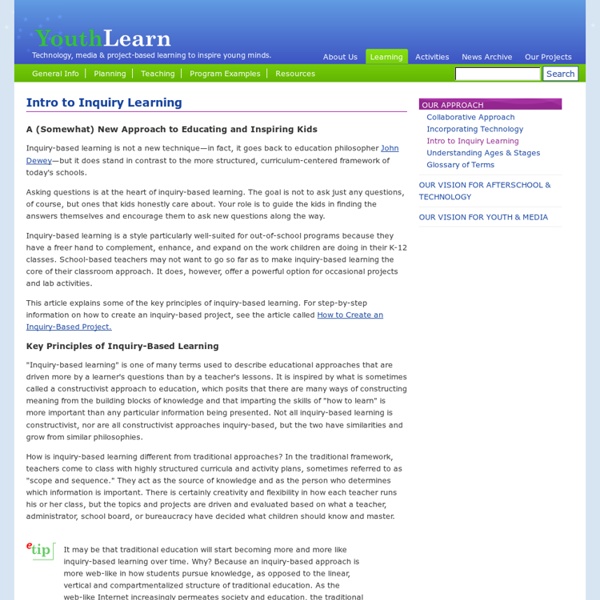Intro to Inquiry Learning

Inquiry-based Learning: Explanation
What is inquiry-based learning? An old adage states: "Tell me and I forget, show me and I remember, involve me and I understand." The last part of this statement is the essence of inquiry-based learning, says our workshop author Joe Exline 1. Inquiry implies involvement that leads to understanding. Furthermore, involvement in learning implies possessing skills and attitudes that permit you to seek resolutions to questions and issues while you construct new knowledge. "Inquiry" is defined as "a seeking for truth, information, or knowledge -- seeking information by questioning." A Context for Inquiry Unfortunately, our traditional educational system has worked in a way that discourages the natural process of inquiry. Some of the discouragement of our natural inquiry process may come from a lack of understanding about the deeper nature of inquiry-based learning. Importance of Inquiry Memorizing facts and information is not the most important skill in today's world. The Application of Inquiry
Inquiry Based Learning
Effective inquiry is more than just asking questions. Inquiry-based learning is a complex process where students formulate questions, investigate to find answers, build new understandings, meanings and knowledge, and then communicate their learnings to others. In classrooms where teachers emphasize inquiry-based learning, students are actively involved in solving authentic (real-life) problems within the context of the curriculum and/or community. These powerful learning experiences engage students deeply. Research suggests that inquiry-based learning increases student creativity, independence, and problem solving skills, and it improves student achievement. A model for inquiry was developed by Alberta Education to support the work of teachers and students. Explore other Education and Government initiatives and resources: Resources related to Inquiry from National Organizations: Resources related to Inquiry from International Organizations:
What Is Inquiry?
Read Article in Spanish Inquiry is a dynamic process of being open to wonder and puzzlement and coming to know and understand the world. As such, it is a stance that pervades all aspects of life and is essential to the way in which knowledge is created. Inquiry is based on the belief that understanding is constructed in the process of people working and conversing together as they pose and solve the problems, make discoveries and rigorously testing the discoveries that arise in the course of shared activity. Misconception Alert “Inquiry is not a “method” of doing science, history, or any other subject, in which the obligatory first stage in a fixed, linear sequence is that of students each formulating questions to investigate. Inquiry is a study into a worthy question, issue, problem or idea. There are several dimensions of inquiry: These are taken from the Inquiry Rubric Reference (1) Wells, Gordon (2001).
Learning - About Us
Related:
Related:



